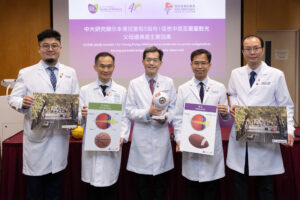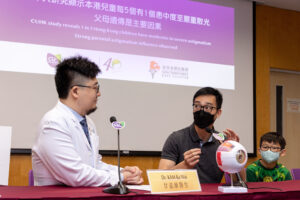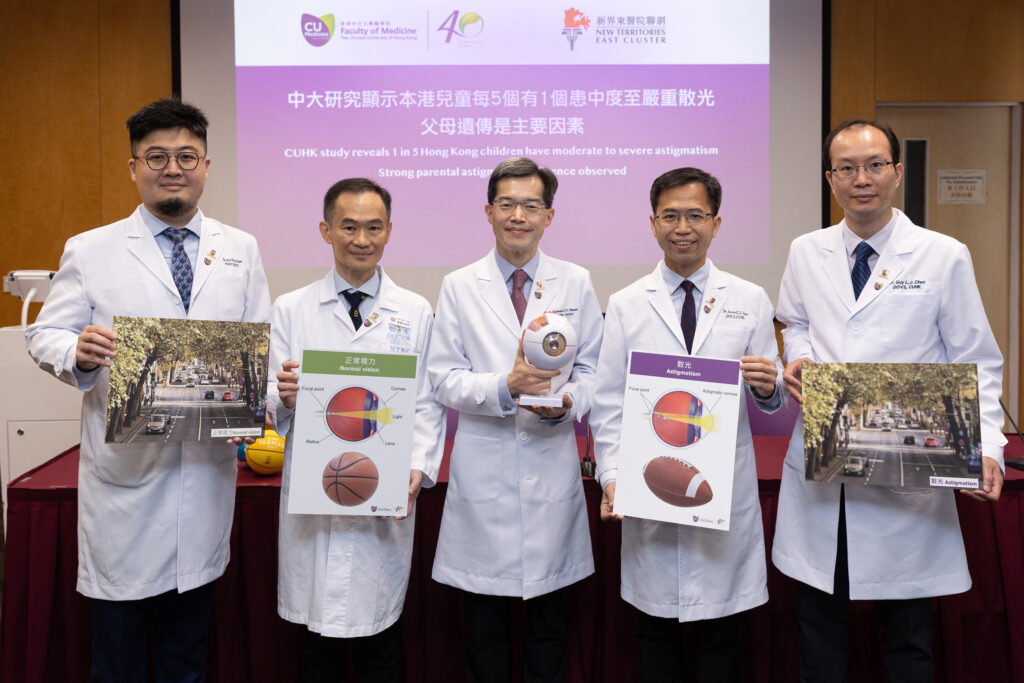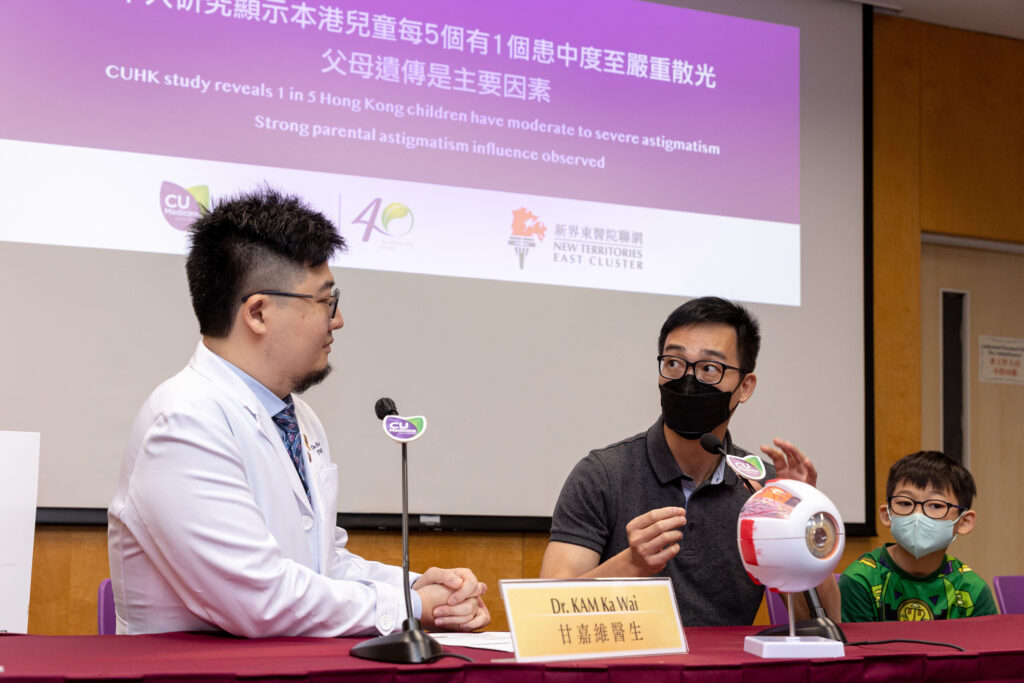CUHK
News Centre
CUHK study reveals 1 in 5 Hong Kong children have moderate to severe astigmatism Strong parental astigmatism influence observed
Astigmatism is the most common refractive error worldwide, with a greater global prevalence than myopia and hyperopia, and it can lead to amblyopia if untreated. The Chinese University of Hong Kong’s (CUHK) Faculty of Medicine (CU Medicine) conducted two population-based, cross-sectional studies to evaluate the prevalence of astigmatism in Hong Kong and the association between child and parental astigmatism. Results showed that children in Hong Kong exhibited a higher prevalence of astigmatism than in overseas cities and that 1 in 5 children aged 6 to 8 suffered from moderate to severe astigmatism. Researchers also observed a strong correlation between parental and child astigmatism. Children were at more than three times higher risk of developing astigmatism if both parents had severe astigmatism. Details were published in the international journals Eye-Nature and JAMA Network Open.
Untreated astigmatism can lead to amblyopia
Astigmatism occurs when the cornea curvatures are unequal, in which circumstance light rays do not converge at a single focal point, leading to the formation of a blurred image.
Professor Clement CY Tham, Chairman and S. H. Ho Professor of Ophthalmology and Visual Sciences of the Department of Ophthalmology and Visual Sciences at CU Medicine, remarked, “Astigmatism prevents a clear vision at any distance during a child’s development which may negatively affect cognitive functions, language ability, and motor tasks. Untreated astigmatism can lead to amblyopia, more commonly known as lazy eye. The golden time of treatment for amblyopia is before the age of eight.”
Professor Guy LJ Chen, Professor of the Department of Ophthalmology and Visual Sciences at CU Medicine, added, “Astigmatism has been observed to be more prevalent among Chinese children when compared with other populations. It is usually inherited from the parents. Myopia also plays a role. Studies are now speculating that reading habit is a potential risk factor.”
High prevalence of astigmatism concurs with high prevalence of myopia in HK
CU Medicine’s Department of Ophthalmology and Visual Sciences analysed a total of 3,704 school children and 5,577 adults from the Hong Kong Children Eye Study, which is an ongoing population-based study focusing on eye conditions in primary school children aged 6 to 8 years in Hong Kong. This study aimed to determine the prevalence of astigmatism and evaluate the associations between different astigmatism components, including refractive astigmatism (RA) and corneal astigmatism (CA).
Results showed school children in Hong Kong has a greater RA (21.9%) and CA (63.9%) prevalence than in other parts of the world. An association of astigmatism with myopia was confirmed as well. (Detailed figures are enlisted in Table 1 in the appendix)
Dr Jason CS Yam, Associate Professor of the Department of Ophthalmology and Visual Sciences at CU Medicine, said, “Astigmatism is known for its association with myopia. Hong Kong is among cities with the highest prevalence of myopia in the world, affecting more than 40% of school children at the age of eight. This may explain why we also have a high prevalence of astigmatism. The high prevalence of astigmatism among both children and adults has led us to ask the next question. How is parental astigmatism going to affect their child?”
Child CA risk is three times higher if parents have high astigmatism
To answer that question, the research team looked at 5,708 family trios, consisting of a child and both parents, in order to investigate the influence of parental astigmatism on children. Examining data from 17,124 subjects, researchers concluded that among other reported biological, environmental, and sociodemographic factors, parental astigmatism was shown to be the most important factor associated with child astigmatism and both parents were associated with the inheritance of astigmatism. The team categorised children into six groups based on the severity of astigmatism of both parents and calculated the corresponding risks in their children. (See details in Table 2 in the appendix)
Dr Kam Ka-wai, Clinical Assistant Professor (honorary) of the Department of Ophthalmology and Visual Sciences at CU Medicine, said, “To the best of our knowledge, this is the first population-based, cross-sectional study to quantify the associations of parental astigmatism with child astigmatism. We found that the prevalence of both RA and CA in children increased with both the number of parents with astigmatism and the severity of parental astigmatism. For example, children were at 62% higher risk of RA if both parents had moderate astigmatism (of 1.0 dioptre of more). And, the risk of child CA nearly doubled if both parents had moderate astigmatism of ≥1.0D and increased by more than three times if both parents had severe astigmatism of ≥2.0D.”
Professor Alvin L Young, Clinical Professor (honorary) of the Department of Ophthalmology and Visual Sciences at CU Medicine, remarked, “The stratification into six groups serves as a clinical guide for clinicians when they counsel parents with astigmatism, in addition to allowing better triage of resources and targeting of preschool children of astigmatic parents for any uncorrected astigmatism. Children with parents with astigmatism should have an early eye examination for a timely detection of astigmatism so that appropriate vision correction can be initiated for a healthy visual development.”

CU Medicine studies found that 1 in 5 children in Hong Kong aged 6 to 8 suffered from moderate to severe astigmatism. Researchers also observed a strong correlation between parental and child astigmatism.
(From left) Honorary Clinical Assistant Professor Dr Kam Ka-wai, Honorary Clinical Professor Professor Alvin L Young, Department Chairman Professor Clement CY Tham, Associate Professor Dr Jason CS Yam and Professor Guy Chen of CU Medicine’s Department of Ophthalmology and Visual Sciences.

Mr Wan says he noticed his son was having difficulty to write a character neatly at the age of five and that he hadn’t had imagined it was related to visual problem. Elon was later diagnosed with astigmatism through CUHK Children Eye Care programme and then realised the reason of his learning issue.





